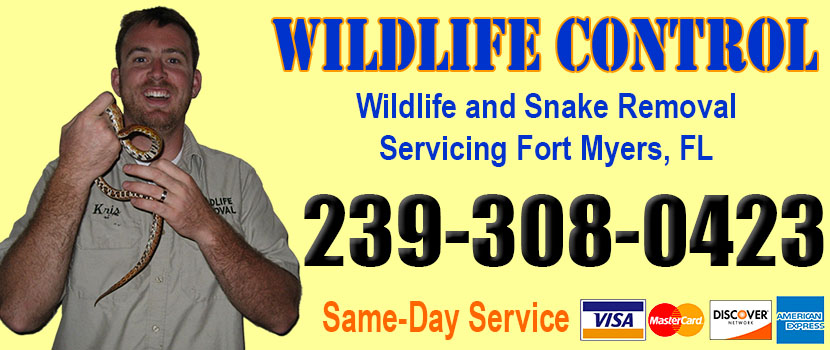
Welcome to fortmyerssnakes.com! I am David, a snake enthusiast living in Fort Myers, FL. Many people don't know that Fort Myers is in fact full of snakes! You just need to know where to find them - they can often be shy and elusive. Some Florida snake species are more common outside of the city limits, in different parts of Lee County FL, but many types of snakes are indeed common in the more urban parts of Fort Myers. This guide is meant to help educate you about the beautiful snakes of Fort Myers, and to help you identify the most common snakes of Fort Myers, as well as the venomous snakes of Fort Myers that you should learn to recognize and avoid. If you want more detail, click here for my complete list of ALL snake species in Fort Myers. Remember the following:
- Most snakes of Fort Myers are harmless and don't want to encounter you
- Venomous snakes exist but are uncommon in Fort Myers, Florida
- Snakes eat rats and mice and are a valuable part of the Florida ecosystem
- Never kill a snake - if you leave a snake alone, it will leave you alone.
Common Snake Species in Fort Myers
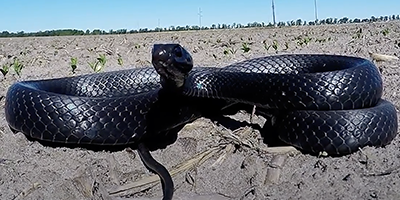 Black Racer Snake:
The black racer snake is a small to medium-sized, nonvenomous snake that’s found all over Florida. These snakes are typically between two to four feet long, and you can identify them by their dark body and white chin. Yet this species’ young look quite different and are grey with reddish-brown splotches across their entire body.
These snakes can adapt to a variety of habitats. That’s why you’ll find them living in forests, prairies, and sandhills. In recent years, these snakes have also been showing up near suburban homes.
Like many other snake species, the black racer snake has a varied diet. They’ll eat anything from small insects and spiders to birds and small rodents. These snakes are also known to go after bird eggs, amphibians, and even other reptiles.
Black Racer Snake:
The black racer snake is a small to medium-sized, nonvenomous snake that’s found all over Florida. These snakes are typically between two to four feet long, and you can identify them by their dark body and white chin. Yet this species’ young look quite different and are grey with reddish-brown splotches across their entire body.
These snakes can adapt to a variety of habitats. That’s why you’ll find them living in forests, prairies, and sandhills. In recent years, these snakes have also been showing up near suburban homes.
Like many other snake species, the black racer snake has a varied diet. They’ll eat anything from small insects and spiders to birds and small rodents. These snakes are also known to go after bird eggs, amphibians, and even other reptiles.
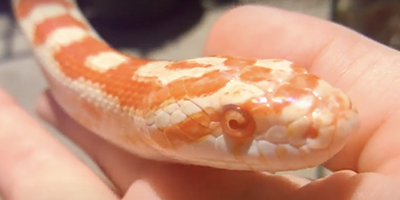 Corn Snake:
The corn snake, also known as the red rat snake, is a non-venomous species of snake. These animals come in a variety of shapes and sizes, and some are as small as two feet long. While others can grow up to six feet in length.
Corn snakes get their name from their red and yellow bodies, which are covered in red blotches. From a distance, these markings make the snake resemble some types of corn.
You can find these snakes in a wide variety of locations, from meadowlands to fields and barns. While in these areas, this snake species will primarily hunt and prey on mice and rats. Yet they’re also known to go after birds, bats, and even some frogs.
These snakes are constrictors, so they capture and kill their prey by squeezing them until they die.
Corn Snake:
The corn snake, also known as the red rat snake, is a non-venomous species of snake. These animals come in a variety of shapes and sizes, and some are as small as two feet long. While others can grow up to six feet in length.
Corn snakes get their name from their red and yellow bodies, which are covered in red blotches. From a distance, these markings make the snake resemble some types of corn.
You can find these snakes in a wide variety of locations, from meadowlands to fields and barns. While in these areas, this snake species will primarily hunt and prey on mice and rats. Yet they’re also known to go after birds, bats, and even some frogs.
These snakes are constrictors, so they capture and kill their prey by squeezing them until they die.
Venomous Snake Species in Fort Myers
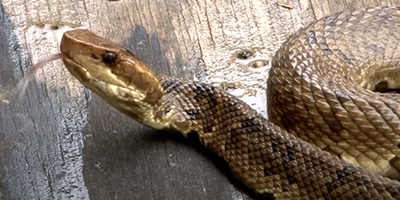 Cottonmouth:
Cottonmouths are venomous water snakes, and they’re very dangerous. These snakes are between two to four feet long, but they have large, heavily built bodies. Cottonmouths are typically brown, with crisscross patterns of lighter and darker shades. Yet as these animals age, their body becomes darker and they soon appear to be entirely black.
Cottonmouths are quite common in Florida, and they can be found in every county in the state. Because of their status as water snakes, the cottonmouth tends to spend most of its life near bodies of water. This includes rivers, ponds, lakes, and even canals. These snakes don’t necessarily live in the water, as they can be found some distance away from these bodies of water.
These snakes get their name from their defensive behavior, where they expose the white interiors of their mouths to ward off any potential threats.
Cottonmouths typically go after other animals living near bodies of water. These include fish, amphibians, other snakes, and even small alligators. Yet they’re also known to hunt small mammals or birds when the opportunity presents itself.
Cottonmouth:
Cottonmouths are venomous water snakes, and they’re very dangerous. These snakes are between two to four feet long, but they have large, heavily built bodies. Cottonmouths are typically brown, with crisscross patterns of lighter and darker shades. Yet as these animals age, their body becomes darker and they soon appear to be entirely black.
Cottonmouths are quite common in Florida, and they can be found in every county in the state. Because of their status as water snakes, the cottonmouth tends to spend most of its life near bodies of water. This includes rivers, ponds, lakes, and even canals. These snakes don’t necessarily live in the water, as they can be found some distance away from these bodies of water.
These snakes get their name from their defensive behavior, where they expose the white interiors of their mouths to ward off any potential threats.
Cottonmouths typically go after other animals living near bodies of water. These include fish, amphibians, other snakes, and even small alligators. Yet they’re also known to hunt small mammals or birds when the opportunity presents itself.
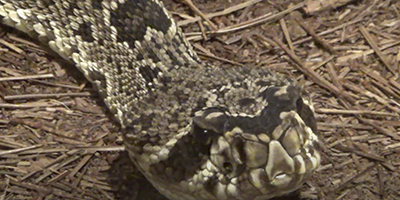 Eastern Diamondback Rattlesnake:
The eastern diamondback rattlesnake is one to watch out for. These snakes are venomous and are a serious threat. They’re big, so you won’t have much trouble spotting them. In fact, these snakes can grow up to six feet long.
These snakes are called diamondbacks because of the dark, diamond-shaped pattern that runs down their back.
Diamondbacks can often be found hunting and preying on small mammals like rats and rabbits.
Eastern Diamondback Rattlesnake:
The eastern diamondback rattlesnake is one to watch out for. These snakes are venomous and are a serious threat. They’re big, so you won’t have much trouble spotting them. In fact, these snakes can grow up to six feet long.
These snakes are called diamondbacks because of the dark, diamond-shaped pattern that runs down their back.
Diamondbacks can often be found hunting and preying on small mammals like rats and rabbits.
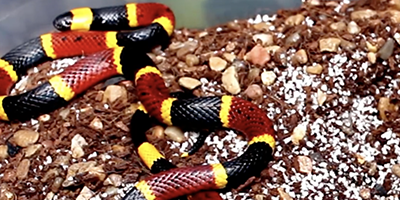 Eastern Coral Snake:
The eastern coral snake is a small venomous species that can be found in Florida. These snakes are only two feet long, but their eye-catching pattern makes them easy to spot. These coral snakes have large alternating sections of red and black rings, separated by small yellow bands.
What makes these snakes unique is that they primarily prey on other snakes and reptiles. Once they find their target, they use their powerful venom to kill it.
Eastern Coral Snake:
The eastern coral snake is a small venomous species that can be found in Florida. These snakes are only two feet long, but their eye-catching pattern makes them easy to spot. These coral snakes have large alternating sections of red and black rings, separated by small yellow bands.
What makes these snakes unique is that they primarily prey on other snakes and reptiles. Once they find their target, they use their powerful venom to kill it.
If you're unsure, you can email me a photo of the snake at info@fortmyerssnakes.com and I will email you back with the snake's species. If you found a snake skin, read my Found a Skin? page, and you can email me a photo of the skin, and I'll identify the snake for you. If you need professional Fort Myers snake removal help, click my Get Help page, or see the below website sponsor I found, who provides that service.
Are there any animals that catch and kill snakes?
The Predators of the Snake
Snakes seem like scary creatures with few predators. They can slither away and they can hide, making them hard for anyone to catch. Besides, what would want to catch one? They do not seem like a great meal option, at least to most humans. There are animals out there that like to eat them, though. There are tons of animals that hunt them. Successfully, too, as they have quite a few predators. The predators do depend on the location. Not all snakes have the same predators, as not all predators are in the same locations. It depends entirely on the type of snake and the location.
Common Predators
Birds, gators, large mammals, and larger snakes are all predators – and they are only some of them. Anything large that can capture the snake is a potential predator. Snakes do not have a lot of self-defense. They rely on their slithery, hard-to-catch bodies to get away and keep themselves safe. They can bite, or use venom if they are venomous, but that is if they can get the bite. If the snake cannot bite, or has no venom, the predator has an easy kill. That is, if the snake is out in the open. Snakes can hide and will use tall grass, objects, trees, rocks, and whatever else for shelter. This keeps the snakes out of the view, mostly, of predators. Snakes must live in areas with cover to keep themselves away from predators.
Locations
The exact predators and the type of shelter depend on the location. Not all locations are equal, obviously. Some areas may have trees and canopies and rocks, with birds flying overhead, while others may be in swamps with gators. There are tons of animals, big and small, that will go after snakes. Snakes all over the globe, in deserts and in forests and in all other types of environments, have predators. To learn more about specific predators, you have to look at specific locations. Even massive pythons have their own predators. It all depends on what is in the area. All animals in their natural habitats have predators. Snakes, too, have predators. There are different types, depending on the location, but they all pose a serious threat to snakes and can easily grab and kill one. It is part of any healthy ecosystem. Like snakes have their own prey, snakes are prey to other animals.
Remember, the term is not poisonous snakes of Fort Myers, it's venomous snakes of Fort Myers. Poison is generally something you eat, and venom is injected into you. That said, dangerous snakes are very rare in Fort Myers. The few venomous snakes of Lee County are rarely seen. But they are commonly misidentified, so learn about all the snake species of Fort Myers in order to correctly identify them. These snakes are usually also found in the surrounding towns of Fort Myers, Cape Coral, Bonita Springs, Lehigh Acres, Estero, Sanibel, Fort Myers Beach, North Fort Myers, Alva, Captiva, Saint James City, San Carlos Park, Bokeelia, Matlacha, Cypress Lake, Gateway, Buckingham, Punta Rassa, Three Oaks, Iona, Whiskey Creek, Fort Myers Shores, Burnt Store Marina, Pine Manor, Pineland, Suncoast Estates, Pine Island Cente, Palmona Par, Matlacha Isles-Matlacha Shores, Tice, Page Park, Villas, Harlem Heights, McGregor, Olg and the surrounding areas.
Read our article about:
What do snakes eat and how does it catch it?
fortmyerssnakes.com domain and hosting costs made possible by the generous support of this sponsor:
